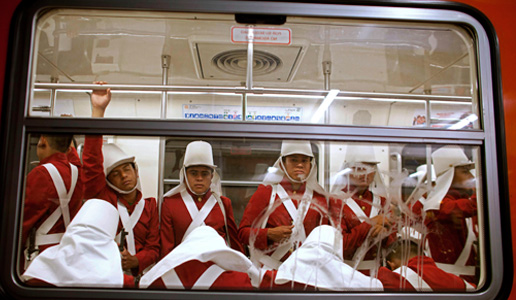
On Sept.16, Mexico celebrated its two hundred and second independence day. Is independence slipping through the Mexican people’s fingers?
Mexican independence from Spain is traditionally dated from the evening in which Father Miguel Hidalgo y Costilla, the parish priest of Dolores in the state of Guanajuato, issued the “grito” (shout), “Viva la Virgen de Guadalupe y muera el mal gobierno” (“Long live the Virgin of Guadalupe and death to the bad government”). Hidalgo had been part of a discussion group that had been talking about independence; his “grito” was issued as an emergency call to arms when news came to him that the repressive Spanish colonial government was on to his group and that arrests might follow.
The uprising sparked by Hidalgo and his friends was huge and bloody. Soon, Spanish troops got the upper hand, defeated the rebels and executed their leaders, including Hidalgo. It was not until 1821 that Mexico actually achieved independence.
There followed many years of coups d’état, dictators, foreign invasions and civil wars. In 1836, U.S. adventurers grabbed Texas. In 1846, U.S. troops seized California, Nevada, Utah, Arizona, Colorado and New Mexico. Yet the reenactment of the “grito” happens in the evening every September 15, albeit with altered words. This year, outgoing president Felipe Calderon Hinojosa donned the presidential sash once more, and issued the “grito” from the balcony of the National Palace in Mexico City.
But two hundred and two years on, how is independence doing?
Mexico has not joined the “Bolivarian” movement for horizontal integration of Latin America and opposition to U.S. hegemony spearheaded by the left wing governments of Cuba, Bolivia, Ecuador and Venezuela. It has not integrated itself into the major economic and trade blocs – UNASUR, MERCOSUR and others – that include practically all the major countries of Latin America.
Rather, Mexico has joined the Pacific Alliance, initiated on June 6 of this year, consisting of countries with conservative governments dependent on the United States, namely Colombia, Chile and Peru (Costa Rica and Panama are associate members).
The Pacific Alliance touts itself as a bastion of “free trade,” and is geographically situated so as to play a major role in trans-Pacific commerce in the future, in the transpacific trade agreement which worries U.S. labor.
All the other full members of the Pacific Alliance are also members of MERCOSUR and UNASUR. Mexico stands alone and is by far the largest economy in the Pacific Alliance. Mexico’s gross domestic product for 2011 was 1 trillion, 155 billion dollars, Colombia’s was 332 billion, Chile’s 249 billion and Peru’s 177 billion. So without Mexico, the Pacific Alliance would be dwarfed by UNASUR and MERCOSUR.
See it as a weapon
The right and international monopoly capital also see the Pacific Alliance as a weapon to wield against the left-leaning Latin American governments, a scenario which can only work with Mexico included.
Still, for Mexico, economic integration with the United States is a far bigger fact than integration with Latin America. The North American Free Trade Agreement (NAFTA) came into force on January 1 1994. Today 80 percent of Mexico’s exports go to the United States, while 50 percent of its imports come from the United States.
NAFTA was supposed to use the destructive force of “free trade” to wipe out inefficient industries in Mexico, such as the cultivation of grain crops for subsistence and local markets, and replace them with taxpayer-subsidized cheap imports from the United States and Canada. This was supposed to force rural people into the cities to provide a cheap labor force for Foreign Direct Investment (FDI) which would help Mexico to become more industrialized. In agriculture, a new emphasis in growing specialty fruits and vegetables for export was supposed to help absorb the millions of displaced grain farmers.
In reality, the grain farmers were duly decimated, but neither the new FDI nor the cultivation of specialty fruits and vegetables for export could make up for the loss of work. Rather, NAFTA fed a massive increase in undocumented migration to the United States, as well as providing an unending supply of desperate recruits for the international narcotics trade.
NAFTA has made some people rich, but impoverished many more. Transnational corporations and billionaires in all three countries have done well, while workers plus small farmers in Mexico have done poorly. Feeding its people is now a problem for Mexico.
As the drug trade has boomed, Mr. Calderon’s right-wing government initiated a military strategy to combat it. The United States, which provides the vast market for the drugs as well as the weapons the drug cartels use to fight it out among themselves and against the Mexican government, has backed up Calderon’s strategy with massive military aid. The result has been no lessening of the drug trade, but up to 80,000 deaths, with Mexico more dependent on the United States than ever.
The priorities of the new president, Enrique Peña Nieto, who takes office on December 1, are a stealth privatization of the Mexican oil industry (more money for international monopoly capital, less control by Mexico of a key resource) and a labor “reform” that will entail even more suppression of workers.
The good news is that millions of Mexican workers, farmers, intellectuals and students are not taking this lying down.
Hidalgo’s “grito” was launched against “the bad government” of Spanish colonialism; the “gritos” of millions of Mexicans today are launched against imperialism and its tools.
Photo: Members of the Mexican army wearing historical uniforms sit in subway car on the way to downtown Mexico City for the military parade at Independence Day celebrations, Sept. 16. Alexandre Meneghini/AP












Comments